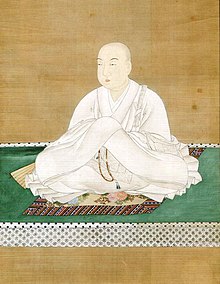| Emperor Seiwa 清和天皇 | |||||
|---|---|---|---|---|---|
 | |||||
| Emperor of Japan | |||||
| Reign | October 7, 858 – December 18, 876 | ||||
| Coronation | December 15, 858 | ||||
| Predecessor | Montoku | ||||
| Successor | Yōzei | ||||
| Born | May 10, 850 Heian Kyō (Kyōto) | ||||
| Died | January 7, 881 (aged 30) Heian Kyō (Kyōto) | ||||
| Burial | Minooyama no misasagi (水尾山陵) (Kyoto) | ||||
| Issue Among others... | Emperor Yōzei | ||||
| |||||
| House | Yamato | ||||
| Father | Emperor Montoku | ||||
| Mother | Fujiwara no Akirakeiko | ||||
Emperor Seiwa (清和天皇, Seiwa-tennō, May 10, 850 – January 7, 881) was the 56th emperor of Japan,[1] according to the traditional order of succession.[2]
Seiwa's reign spanned the years from 858 through 876.[3]
Seiwa was the fourth son of Emperor Montoku. His mother was Empress Dowager Fujiwara no Akirakeiko (明子), also called the Somedono empress (染殿后). Seiwa's mother was the daughter of Fujiwara no Yoshifusa (藤原良房), who was regent and great minister of the council of state.[4] He was the younger half-brother of Imperial Prince Koretaka (惟喬親王; 844–897)
Before his ascension to the Chrysanthemum Throne, his personal name (his imina)[5] was Korehito (惟仁),[6] the first member of the Imperial house to be personally named "-hito" 仁. One meaning of the character 仁 is the Confucian concept of ren. Later it has been a tradition to name the personal name of all male members of the Imperial family this way.
He was also known as emperor as Mizunoo-no-mikado[4] or Minoo-tei.[7]
Originally under the guardianship of his maternal grandfather Fujiwara no Yoshifusa, he displaced Imperial Prince Koretaka (惟喬親王) as Crown Prince. Upon the death of his father in 858, Emperor Montoku, he became Emperor at the age of 9, but the real power was held by his grandfather, Yoshifusa.
The actual site of Seiwa's grave is known.[1] The emperor is traditionally venerated at the misasagi memorial shrine in the Ukyō-ku ward of Kyoto. The Imperial Household Agency designates this location as Seiwa's mausoleum. It is formally named the Minooyama no Misasagi (清和天皇陵) or Seiwa Tennō Ryō.[15][16] From the site of his tomb the Emperor Seiwa is sometimes referred to as the Emperor Mizunoo (水尾帝, Mizunoo-tei).[17] The kami of Emperor Seiwa is venerated at the Seiwatennō-sha near the mausoleum.[18][19]
Kugyō (公卿) is a collective term for the very few most powerful men attached to the court of the Emperor of Japan in pre-Meiji eras.[20]
In general, this elite group included only three to four men at a time. These were hereditary courtiers whose experience and background would have brought them to the pinnacle of a life's career. During Seiwa's reign, this apex of the Daijō-kan included:
The years of Seiwa's reign are more specifically identified by more than one era name or nengō.[6]
| Ancestors of Emperor Seiwa | |||||||||||||||||||||||||||||||||||||||||||||||||||||||||||||||||||||||||||||||||||||||||||||||||||||||||||||||||||||||||||||||||||||||||||||||||||||||||||||||||||||||||||||||||||||||||||||||||||||||||||||||||||||||||||||||||||||||||||||||||||||||||||||||||||||||||||||||||||||||||
|---|---|---|---|---|---|---|---|---|---|---|---|---|---|---|---|---|---|---|---|---|---|---|---|---|---|---|---|---|---|---|---|---|---|---|---|---|---|---|---|---|---|---|---|---|---|---|---|---|---|---|---|---|---|---|---|---|---|---|---|---|---|---|---|---|---|---|---|---|---|---|---|---|---|---|---|---|---|---|---|---|---|---|---|---|---|---|---|---|---|---|---|---|---|---|---|---|---|---|---|---|---|---|---|---|---|---|---|---|---|---|---|---|---|---|---|---|---|---|---|---|---|---|---|---|---|---|---|---|---|---|---|---|---|---|---|---|---|---|---|---|---|---|---|---|---|---|---|---|---|---|---|---|---|---|---|---|---|---|---|---|---|---|---|---|---|---|---|---|---|---|---|---|---|---|---|---|---|---|---|---|---|---|---|---|---|---|---|---|---|---|---|---|---|---|---|---|---|---|---|---|---|---|---|---|---|---|---|---|---|---|---|---|---|---|---|---|---|---|---|---|---|---|---|---|---|---|---|---|---|---|---|---|---|---|---|---|---|---|---|---|---|---|---|---|---|---|---|---|---|---|---|---|---|---|---|---|---|---|---|---|---|---|---|---|---|---|---|---|---|---|---|---|---|---|---|---|---|---|---|---|---|
| |||||||||||||||||||||||||||||||||||||||||||||||||||||||||||||||||||||||||||||||||||||||||||||||||||||||||||||||||||||||||||||||||||||||||||||||||||||||||||||||||||||||||||||||||||||||||||||||||||||||||||||||||||||||||||||||||||||||||||||||||||||||||||||||||||||||||||||||||||||||||